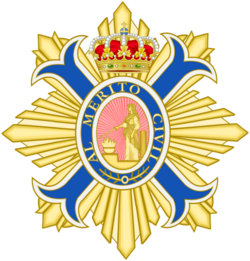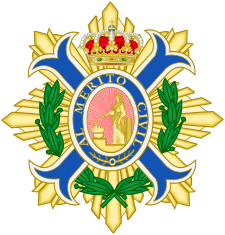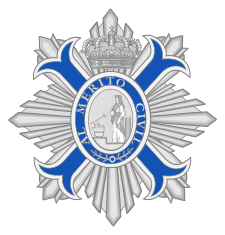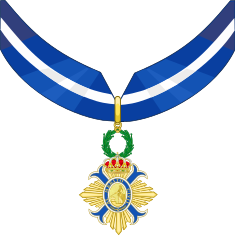Order of Civil Merit facts for kids
Quick facts for kids Royal Order of Civil MeritReal Orden del Mérito Civil |
|
|---|---|

Grand Cross set of insignia of the Order
|
|
| Awarded by the Spanish Monarch |
|
| Type | Order of merit, Knighthood |
| Established | 1926 |
| Royal house | House of Bourbon-Spain |
| Motto | "Al Mérito Civil" For Civil Merit |
| Eligibility | Spanish and Foreign citizens |
| Awarded for | Extraordinary services for the good of the Nation |
| Status | Currently Constituted |
| Grand Master | King Felipe VI |
| Grand Chancellor | José Manuel Albares, Minister of Foreign Affairs |
| Chancellor | Undersecretary of Foreign Affairs |
| Grades | Collar Grand-Cross Commander by Number Commander Officer Cross Cross Silver Cross |
| Post-nominals | OMC |
| Former grades | Grand-Cross Commander by Number Commander Knight Silver Cross |
| Precedence | |
| Next (higher) | De facto, there is no higher civil order. De jure, the Order of Charles III is the higher civil honour; however, it is almost exclusively granted to government ministers. |
| Next (lower) | Civil Order of Alfonso X, the Wise |
| Equivalent | Order of Isabella the Catholic (for diplomatic relations) |
The Ribbons of the Order |
|
The Royal Order of Civil Merit (Spanish: Real Orden del Mérito Civil) is a special award given by the Kingdom of Spain. It's one of the three most important "orders of merit" in Spain. An order of merit is like a club of people who have done great things. This award is often called OMC for short.
The Order of Civil Merit was started by King Alfonso XIII of Spain in 1926. Its main goal is to honor people who have done amazing things for their country. This includes government workers and regular citizens, both Spanish and foreign. It's given for "extraordinary services" that help the nation.
Today, a law from 1998 guides how the Order works. It says the award is for "civil merits." This means it's for people who work for the government or for others who have helped the country in special ways. This could be through great work, helping others, or showing amazing dedication. People from other countries can also receive it if they have helped Spain or worked well with the nation.
The Order of Civil Merit is highly respected in Spain and around the world. This is because it helps Spain build good relationships with other countries. It's also a very special award that not many people receive. Compared to similar awards in other countries, fewer people get the Order of Civil Merit. People who receive the award also get special honors. These include a special way to be addressed, the right to show the award on their coat of arms, and the right to wear the medal and ribbon.
Contents
History of the Order
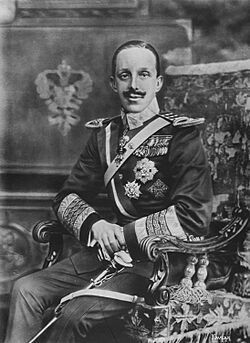
King Alfonso XIII created the Royal Order of Civil Merit on June 25, 1926. He did this with the idea from his Prime Minister, General Miguel Primo de Rivera. The first rules for the Order were published in May 1927.
The Order was made to honor good citizens and government workers. It was for those who did amazing things for Spain. It could also be given to people from other countries as a sign of friendship.
From the start, it was a very desired award. Only a select number of people could receive it in each category:
- Grand Cross: Limited to 250 people.
- Commander by Number: Limited to 350 people.
- Commander: Limited to 500 people.
- Knight: Limited to 1,000 people.
- Silver Cross: No limit.
The King decided who received the award. For the Grand Cross, the government also had to agree. Each award needed a good reason, and special papers were given to those who received it.
For a short time, in 1931, the government of the Republic stopped this Order. They wanted to create a new one. But in 1942, the Order of Civil Merit was brought back. It kept its old features and honors. New categories were added, like "Officer" and "Ribbon."
Later, in 1957, the highest award, the "Knight of the Collar," was created. This special award is usually only for kings, queens, or leaders of countries. It can also be given to very important people who already have the Grand Cross.
Over the years, Spain changed a lot. So, in 1998, new rules were made for the Order. These new rules brought together all the old ones. They also made some important changes. For example, old names like "Lady's Band" were removed. Now, awards like "Grand Cross" or "Cross" can be given to both men and women. This makes sure there is no unfair treatment based on gender.
The new rules also allow women to wear the awards in a slightly different way. This is for comfort and style, especially with formal clothes. Also, two new types of awards were added for groups or organizations. These are the "Tie" and the "Honor Plaque."
Finally, the new rules made sure that every award is truly deserved. They set clear reasons for giving the awards. They also explained who can suggest people for the awards and how the process works. This helps make sure the Order remains very special.
Who Leads the Order?
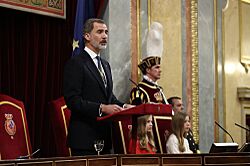
By law, King Felipe VI is the Grand Master of the Order of Civil Merit. This means he is the main leader. All the awards are given in his name.
The Minister for Foreign Affairs, European Union and Cooperation is the Grand Chancellor of the Order. This person suggests who should receive the highest awards, like the Collar and Grand Cross. They also give out the lower awards on behalf of the King. This Minister is also in charge of all the official ceremonies for the Order.
The Under-secretary for Foreign Affairs, European Union and Cooperation is the Chancellor of the Order. This person helps decide who should get the awards. They check all the suggestions and make sure they are suitable.
How Awards Are Given

To receive an award from this Order, people must show certain qualities. Here are some of the things that are considered:
- Doing great services for the country in a civil way.
- Completing amazing projects that are clearly valuable.
- Showing great effort or skill for the good of everyone.
- Starting big projects that help the whole country.
- Doing other good deeds that benefit Spain and should be recognized.
To keep the awards special, the Order's office makes sure each award is truly earned. They check carefully to see if the person deserves it.
The Order's office is part of the Ministry of Foreign Affairs. They handle all the suggestions for awards. They can ask for information from different groups or officials to decide if an award is right.
They also suggest which level of award a person should get. They look at how important their actions were, their job, age, and any other awards they have. Then, they send their suggestion to the Minister of Foreign Affairs. After approval, they prepare the official papers for the awards.
The King of Spain usually gives the awards in a special ceremony. This happens at the Royal Palace on June 19 each year. This date is the anniversary of his becoming King. Sometimes, other ceremonies are held for people from other countries or Spaniards living abroad.
What the Awards Look Like
The main part of the award is a Cross. It is made of gold and is about 48 by 50 millimeters in size. It has four arms shaped like an "X," colored bright blue with white edges. Between the arms are five shiny gold bursts. In the middle, there is a blue oval with "To Civil Merit" written in gold.
Inside the oval, there is a special symbol of the Order. It shows a woman leaning on a column. She holds a sword in her right hand, which looks like it has been made strong by fire. This symbol stands for good civic qualities. A golden Royal Crown of Spain sits above the Cross. The whole award hangs from a green laurel wreath.
The ribbon for the award is blue with a thin white stripe in the middle. The highest award, the "Collar," has a blue ribbon with two white stripes on the edges. Blue stands for nobility, truth, and fairness. White means purity, peace, and honesty. These colors are also important to the House of Bourbon, the Spanish royal family.
The symbols on the award have special meanings:
- Matron (Woman): Represents Spain, honor, dignity, wisdom, and caring.
- Leaning on a Column: Shows stability, support, strength, and how people support society.
- Sword in Right Hand: Stands for the State, justice, protection, and being ready to defend.
- Tempered in the Fire of Sacrifice: Means strength gained through hard times, loyalty, and dedication.
Overall, the award's design shows important qualities like justice, strength, stability, and dedication to helping everyone.
Different Levels of the Award
The Order of Civil Merit has seven different levels, each with its own special badge:
 Collar (Collar) – This is the highest award. It's usually given only to leaders of countries.
Collar (Collar) – This is the highest award. It's usually given only to leaders of countries. Grand Cross (Gran Cruz) – This award comes with a sash and a special star badge.
Grand Cross (Gran Cruz) – This award comes with a sash and a special star badge. Commander by Number (Encomienda de Número) – This award has a silver star badge.
Commander by Number (Encomienda de Número) – This award has a silver star badge. Commander (Encomienda) – This award has a golden star badge worn around the neck.
Commander (Encomienda) – This award has a golden star badge worn around the neck. Officer's Cross (Cruz de Oficial) – This is a golden cross hanging from a ribbon.
Officer's Cross (Cruz de Oficial) – This is a golden cross hanging from a ribbon. Cross (Cruz) – This is a silver cross hanging from a ribbon.
Cross (Cruz) – This is a silver cross hanging from a ribbon.- Silver Cross (Cruz de Plata) – This is a simpler silver cross hanging from a ribbon.
| Insignia | ||||||
| Collar | Collar Grade Star | Grand Cross Star | Commander by Number Star | |||
| Commander | Officer's Cross | Cross | Silver Cross | |||
Special Rights and Honors

When someone receives an award from the Order of Civil Merit, they gain special rights and honors. For example, all awards above the Silver Cross make a person a "Knight" (for men) or "Dame" (for women). So, someone with an Officer's Cross is called a Knight Officer or Dame Officer.
One special honor is a unique way to be addressed:
- Knights or Dames of the Collar or Grand Cross are called "Most Excellent Lord" or "Most Excellent Lady." This is the same way a Duke or Duchess is addressed.
- Knights or Dames Commander by Number are called "Most Illustrious Lord" or "Most Illustrious Lady." This is like how a Marquess or Count is addressed.
- All other Knights are called "Lord," and all other Dames are called "Lady."
- Spanish citizens who are members also get the special title "Don" (for men) or "Doña" (for women) before their name. This is a formal honor, like "Sir" or "Dame" in some other countries.
Members are also expected to wear the Order's badges with formal clothes. They can wear a smaller version, like a rosette or ribbon, with their everyday clothes. Each member also gets an official certificate from the King.
Another honor is the right to add the Order's symbol to their coat of arms. This is a special design that represents their family or achievements. Finally, members often use the letters "OMC" after their name to show they belong to the Order.
Grand Masters of the Order
The Grand Master is the highest leader of the Order. Here are the people who have held this important role:
- Alfonso XIII, King of Spain (1886-1931)
- Francisco Franco, Head of the Spanish State (1936-1975)
- Juan Carlos I, King of Spain (1975-2014)
- Felipe VI, King of Spain (2014-present)
Famous People Who Received the Award
The Collar and Grand Cross are the highest awards. They have been given to kings, queens, country leaders, and other important people.
Country Leaders
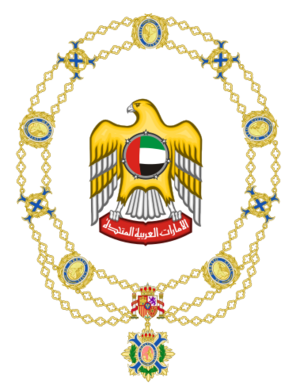
- 2023:
 João Lourenço and Ana Dias Lourenço, President and First Lady of Angola
João Lourenço and Ana Dias Lourenço, President and First Lady of Angola - 2021:
 Moon Jae-in and Kim Jung-sook, President and First Lady of South Korea
Moon Jae-in and Kim Jung-sook, President and First Lady of South Korea - 2012:
 Felipe Calderón Hinojosa, President of Mexico
Felipe Calderón Hinojosa, President of Mexico - 2009:
 Sir Kenneth Hall and Lady Rheima Hall, Governor-General and First Lady of Jamaica
Sir Kenneth Hall and Lady Rheima Hall, Governor-General and First Lady of Jamaica - 2010:
 Petro Poroshenko, President of Ukraine (he was a minister at the time)
Petro Poroshenko, President of Ukraine (he was a minister at the time) - 2008:
 Sheikh Khalifa bin Zayed Al Nahyan, President of the United Arab Emirates
Sheikh Khalifa bin Zayed Al Nahyan, President of the United Arab Emirates - 2007:
 Roh Moo-hyun and Kwon Yang-suk, President and First Lady of South Korea
Roh Moo-hyun and Kwon Yang-suk, President and First Lady of South Korea - 2003:
 Georgi Parvanov and Zorka Parvanova, President and First Lady of Bulgaria
Georgi Parvanov and Zorka Parvanova, President and First Lady of Bulgaria - 2003:
 Ion Iliescu, President of Romania
Ion Iliescu, President of Romania - 2003:
 Islom Karimov, President of Uzbekistan
Islom Karimov, President of Uzbekistan - 2002:
 Abdelaziz Bouteflika, President of Algeria
Abdelaziz Bouteflika, President of Algeria - 1999:
 Petar Stoyanov and Antonina Stoyanova, President and First Lady of Bulgaria
Petar Stoyanov and Antonina Stoyanova, President and First Lady of Bulgaria - 1996:
 Kim Young-sam, President of South Korea
Kim Young-sam, President of South Korea - 1996:
 Leonid Kuchma and Lyudmila Kuchma, President and First Lady of Ukraine
Leonid Kuchma and Lyudmila Kuchma, President and First Lady of Ukraine - 1994:
 Fidel V. Ramos and Amelita Ramos, President and First Lady of the Philippines
Fidel V. Ramos and Amelita Ramos, President and First Lady of the Philippines - 1994:
 Maaouya Ould Sid'Ahmed Taya and Aïcha Mint Ahmed Tolba, President and First Lady of Mauritania
Maaouya Ould Sid'Ahmed Taya and Aïcha Mint Ahmed Tolba, President and First Lady of Mauritania - 1994:
 Árpád Göncz, President of Hungary
Árpád Göncz, President of Hungary - 1993:
 Zhelyu Zhelev and Maria Zheleva, President and First Lady of Bulgaria
Zhelyu Zhelev and Maria Zheleva, President and First Lady of Bulgaria - 1988:
 Bacharuddin Jusuf Habibie, President of Indonesia
Bacharuddin Jusuf Habibie, President of Indonesia - 1979:
 Félix Houphouët-Boigny, President of Côte d'Ivoire
Félix Houphouët-Boigny, President of Côte d'Ivoire - 1978:
 Saddam Hussein, who was then Vice President of Iraq
Saddam Hussein, who was then Vice President of Iraq - 1968:
 Habib Bourguiba and Wassila Ben Ammar, President and First Lady of Tunisia
Habib Bourguiba and Wassila Ben Ammar, President and First Lady of Tunisia - 1965:
 Chiang Kai-shek, President of the Republic of China
Chiang Kai-shek, President of the Republic of China - 1957:
 Camille Chamoun, President of Lebanon
Camille Chamoun, President of Lebanon
Foreign Royal Family Members
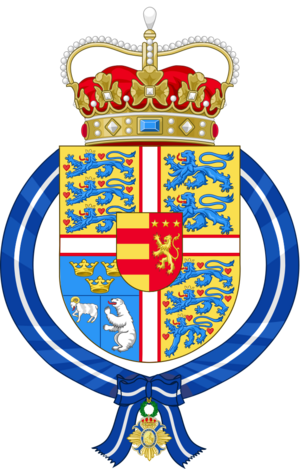
- 2023:
 Prince Joachim of Denmark
Prince Joachim of Denmark - 2023:
 Princess Marie of Denmark
Princess Marie of Denmark - 2021:
 Prince Daniel, Duke of Västergötland of Sweden
Prince Daniel, Duke of Västergötland of Sweden - 2021:
 Princess Sofia, Duchess of Värmland of Sweden
Princess Sofia, Duchess of Värmland of Sweden - 2021:
 Prince Carl Philip, Duke of Värmland of Sweden
Prince Carl Philip, Duke of Värmland of Sweden - 2008:
 H.H.E. Sheikh Sabah Al Ahmed Al Sabah of Kuwait
H.H.E. Sheikh Sabah Al Ahmed Al Sabah of Kuwait - 2008:
 Crown Prince Mohammed bin Zayed of Abu Dhabi (who later became President of the UAE)
Crown Prince Mohammed bin Zayed of Abu Dhabi (who later became President of the UAE) - 2008:
 Crown Prince Hamdan bin Mohammed of Dubai
Crown Prince Hamdan bin Mohammed of Dubai - 2006:
 Princess Märtha Louise of Norway
Princess Märtha Louise of Norway - 2000:
 King Mohammed VI of Morocco
King Mohammed VI of Morocco - 2000:
 Princess Astrid of Belgium
Princess Astrid of Belgium - 2000:
 Prince Lorenz of Belgium
Prince Lorenz of Belgium - 2000:
 Prince Laurent of Belgium
Prince Laurent of Belgium - 1999:
 Princess Alia and her husband Mohammad Al-Saleh of Jordan
Princess Alia and her husband Mohammad Al-Saleh of Jordan - 1995:
 King Ja'afar Yang di-Pertuan Agong of Malaysia
King Ja'afar Yang di-Pertuan Agong of Malaysia - 1995:
 Queen Najihah Raja Permaisuri Agong of Malaysia
Queen Najihah Raja Permaisuri Agong of Malaysia - 1991:
 Prince Karin Aga Khan IV
Prince Karin Aga Khan IV - 1966:
 King Faisal of Saudi Arabia
King Faisal of Saudi Arabia - 1962:
 King Saud of Saudi Arabia
King Saud of Saudi Arabia - 1960:
 King Rama IX of Thailand
King Rama IX of Thailand - 1955:
 Princess Dina of Jordan (who later became Queen of Jordan)
Princess Dina of Jordan (who later became Queen of Jordan)
Other Notable People
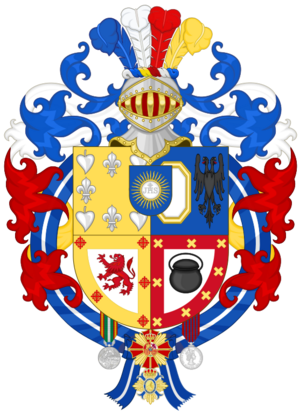
- 2025:
 Daniel Barenboim, a famous musician
Daniel Barenboim, a famous musician - 2024:
 Hanke Bruins Slot, Minister of Foreign Affairs of The Netherlands
Hanke Bruins Slot, Minister of Foreign Affairs of The Netherlands - 2022:
 Wolfgang Schmidt, a German Federal Minister
Wolfgang Schmidt, a German Federal Minister - 2018:
 Monirul Islam, an artist
Monirul Islam, an artist - 2017:
 Nasrul Hamid, a State Minister of Bangladesh
Nasrul Hamid, a State Minister of Bangladesh - 2017:
 Ignacio Echeverría, a hero
Ignacio Echeverría, a hero - 2016:
 Plácido Domingo, a famous singer and conductor
Plácido Domingo, a famous singer and conductor - 2015:
 Sushma Swaraj, Minister of External Affairs of India
Sushma Swaraj, Minister of External Affairs of India - 2015:
 Mohamed Salem Ould Béchir, Interior Minister of Mauritania
Mohamed Salem Ould Béchir, Interior Minister of Mauritania - 2013:
 Fadi Al-Atrash Joumblatt, a musician
Fadi Al-Atrash Joumblatt, a musician - 2009:
 Amancio Ortega, who started the fashion company Zara
Amancio Ortega, who started the fashion company Zara - 2007:
 Miriam Defensor Santiago, a Filipino stateswoman
Miriam Defensor Santiago, a Filipino stateswoman - 2005:
 Abderrahim Harouchi, Moroccan Minister of Public Health
Abderrahim Harouchi, Moroccan Minister of Public Health - 2005:
 Yehudi Menuhim, a famous violinist and conductor
Yehudi Menuhim, a famous violinist and conductor - 1995:
 Miguel Indurain, who won the Tour de France five times
Miguel Indurain, who won the Tour de France five times - 1995:
 Mahathir Mohamad, Prime Minister of Malaysia
Mahathir Mohamad, Prime Minister of Malaysia - 1982:
 Germán Arciniegas, a Colombian writer and historian
Germán Arciniegas, a Colombian writer and historian - 1976:
 Lord Killanin, President of the IOC
Lord Killanin, President of the IOC - 1973:
 Ricardo Armando Novoa Arciniegas, a Salvadorian politician
Ricardo Armando Novoa Arciniegas, a Salvadorian politician - 1966:
 Joaquín Rodrigo, a famous composer
Joaquín Rodrigo, a famous composer - 1968:
 Habib Bourguiba Jr., Minister of Foreign Affairs of Tunisia
Habib Bourguiba Jr., Minister of Foreign Affairs of Tunisia - 1959:
 Juan Antonio Samaranch, President of the IOC
Juan Antonio Samaranch, President of the IOC - 1948:
 J. Hunter Guthrie, an American philosopher
J. Hunter Guthrie, an American philosopher
What Happens When a Member Passes Away
If someone who received the Collar award passes away, their family must return the award's badges to the Order's office. If the family lives outside Spain, they can return it through Spanish embassies or consulates. The Order's office will give them a document saying the award was returned. For all other award levels, the family does not have to return the badges. However, they should still tell the Order's office about the death for their records.
Losing the Award
If someone who has received any level of the Order of Civil Merit is found guilty of a serious wrongdoing by a court, they might lose their award. They could also lose the special honors that come with it. The Order's office can start a process to look into this. The person will have a chance to explain their side. The Minister of Foreign Affairs decides if someone loses the lower awards. For the Collar and Grand Cross, the Council of Ministers makes the decision.
Images for kids
See also
 In Spanish: Orden del Mérito Civil (España) para niños
In Spanish: Orden del Mérito Civil (España) para niños


